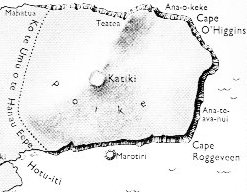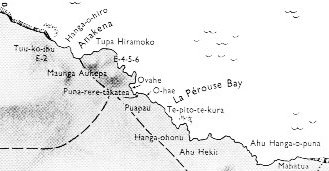1. These are the 24 glyphs in line Ga3:
Line a3 contains the first 6 periods (out of 31) which are defined by a kind of glyph with kiore at left and henua in the center (the important position):
The glyph type in front ought to indicate the opposite of a similar such hanging string, e.g. in Ga1-17:
We should remember:
My name for the glyph type with hanging feathers is maro:
Usually it is not so balanced as in my prototype and instead consists of only a single string of 'feathers'. Such a single feather string is usually hanging down in front. Occasionally it is at left and then we can deduce it signifies a reversal of its normal meaning, which probably is 'end'. Beyond a waning moon crescent (central sign in Ga1-17) comes the end of the 'month'. Maunga Teatea presumably is the 'mountain' behind which Moon slips away, with teatea as the negation of tea (the white colour of Moon). With Moon rising in the west it will disappear in the east:
When a maro string in front is rising up instead of hanging down it should refer to the opposite of 'end', i.e. to 'beginning'. Yet the position of Ga3-5 and the rest of these glyphs evidently are at the end of respective 'period'. My impression is that these rising maro feather strings in front are meant to illustrate the growth of spring. They emerge from the bottom end of henua signs.
Staffs with feathers were set up in the ground to mark boundaries: "... Nuku Keku was ... in charge of the feather garlands (maro), which served to mark the boundaries of the royal residence. He had pounded (the staffs with the feather garlands) into the ground. The middle (te tini) was located in front of the bay of Hanga Rua. The feather garlands went up, continued, and reached Puku Parari. They went up again and reached Puku O Heha. From Puku O Heha they formed (a line) to the side, to Aro Huri. From Aro Huri they turned again toward the sea and reached Maunga Koua, went down, went their way, and reached Hira Moko. (He) made a second line (? he rua taupa) of feather garlands ..." (Manuscript E, p. 91, according to The Eighth Island.) Hanga Rua is a misprint in the translation of Barthel. I suspected it couldn't be a '2nd Bay', because that must be at the end and not in the middle. Perhaps it was a misprint I guessed. And I was right, because according to the original Polynesian version the bay is Hanga Rau (the Bay of Leaves, meaning multiple offspring I think):
Tupa Hiramoko is the cape east of Anakena, presumably the same place as referred to by the 6th and last name mentioned (Hira Moko). The other names cannot be found on my maps. But we know where Hanga Rau is located, that is where the canoe of Hotu Matua (and also the canoe of Ava Rei Pua) anchoraged, just outside Anakena: ... When Hotu's canoe had reached Taharoa, the vaginal fluid (of Hotu's pregnant wife) appeared. They sailed towards Hanga Hoonu, where the mucus (kovare seems to refer to the amniotic sac in this case) appeared. They sailed on and came to Rangi Meamea, where the amniotic fluid ran out and the conctractions began. They anchored the canoe in the front part of the bay, in Hanga Rau. The canoe of Ava Rei Pua also arrived and anchoraged. After Hotu's canoe had anchoraged, the child of Vakai and Hotu appeared. It was Tuu Maheke, son of Hotu, a boy ... (Manuscript E, p. 80) A connection between staffs (uprights) and land (horizontal) was probably thought of as mediated by 'fire' (feathers). Possibly, therefore:
|
||||||||||||||||||||||||||||||||||||||||||||||||||||||||||||||||||||||||||||||||||||||||||||||||||

















